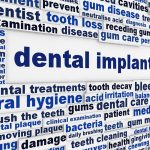
Short-span fixed partial dentures and full-arch fixed prostheses have been constructed by connecting teeth and implants. However, biomechanical differences between tooth and implants mean that tooth micro-mobility is around 10 times that of dental implants. Both rigid and non-rigid connections to implants have been used and there is a debate over which is the best approach.
The aim of this review was to assess the survival, technical and biological complication rates of partial fixed dental prostheses (FDPs) supported by implants and teeth.
Methods
Searches were conducted in the Medline, Embase, and Cochrane databases together with a search of Google Scholar. These were supplemented by hand searches in the journals; Journal of Prosthetic Dentistry, International Journal of Prosthodontics, Journal of Prosthodontics, Journal of Periodontology, Journal of Clinical Periodontology, Periodontology 2000, International Journal of Periodontics and Restorative Dentistry, International Journal of Oral and Maxillofacial Implants, Clinical Oral Implants Research, Clinical Implant Dentistry and Related Research, Implant Dentistry, and Journal of Oral Implantology.
Randomised controlled trials (RCTs), prospective and retrospective cohort studies in partially edentulous patients rehabilitated by non-immediately loaded fixed dental prostheses connecting implants to teeth that included details of the connection/attachment mode (rigid or non-rigid) with a follow up of at least 12 months were considered. Two reviewers independently selected studies and abstracted data. The Cochrane risk of bias tool was used to assess study quality included studies excluding the judgments relevant to randomisation.
Results
- 10 studies (6 retrospective, 4 prospective) were included.
- 4 studies included a control group.
- 3 studies included only rigid fixed reconstructions, with 6 studies reporting on both rigid and non-rigid implant to tooth connection fixed dental prostheses.
- In all studies, the rigid connection mainly involved a vertical or horizontal locking screw, while the non-rigid involved telescopic crowns or sliding type attachments.
- 481 patients received 526 FDPs supported by 981 abutment teeth connected with 1072 implants.
- Dropouts ranged from 0% -11.7%.
- Follow up ranged from 18-120 months.
- Apart from 2 studies all used different methods of determining ‘survival’
- Overall survival rate for implants ranged between 90% and 100
- Survival of the abutment teeth was 94.1-100%,
- Prostheses survival was 85-100% for the same time period.
- Periapical lesions were the most frequent complications at 11.53%.
- The most frequent technical complication were
- porcelain occlusal fracture; 16.6%.
- screw loosening; 15%.
- Meta-analysis ( 3 studies), found no intrusion on the rigid connection group, while five teeth (8.19%) were intruded in the non-rigid connection group .
Conclusions
The authors concluded:-
The tooth-implant FDP seems to be a possible alternative to an implant-supported FDP. There is limited evidence that rigid connection between teeth and implants presents better results when compared with the non-rigid one. The major drawback of non-rigidly connected FDPs is tooth intrusion.
Comments
While a good search strategy was undertaken only English language papers were included which means that potentially relevant studies could have been excluded. A range of study designs were included with a majority of the studies being retrospective. Only 4 of the included studies used a control group and none of the studies were randomised. The studies were relatively small and with relatively short follow up periods as noted by the authors. So while this review helpfully summarise the evidence on this topic the evidence itself is of low quality so the findings should be interpreted with caution. Well-conducted randomised controlled trials of appropriate size and duration are needed to address the questions posed by this review.
Links
Primary paper
Tsaousoglou P, Michalakis K, Kang K, Weber HP, Sculean A. The effect of rigid and non-rigid connections between implants and teeth on biological and technical complications: a systematic review and a meta-analysis. Clin Oral Implants Res. 2016 Jun 28. doi: 10.1111/clr.12890. [Epub ahead of print] Review. PubMed PMID: 27350419.

Fixed dental prostheses: rigid and non-rigid connections to implants https://t.co/AFQTmmTVhT
[…] post Fixed dental prostheses: rigid and non-rigid connections to implants appeared first on National Elf […]
Fixed dental prostheses: rigid and non-rigid connections to implants https://t.co/rID76DNOVy
Rigid or non-rigid connections of fixed dental prostheses to implants? https://t.co/rID76DNOVy
Limited evidence that rigid connection to teeth and implants better than non-rigid https://t.co/rID76DNOVy
Connecting fixed dental prostheses to implants-rigid or non-rigid connections? https://t.co/rID76DNOVy
Don’t miss – Fixed dental prostheses: rigid and non-rigid connections to implants https://t.co/rID76DNOVy